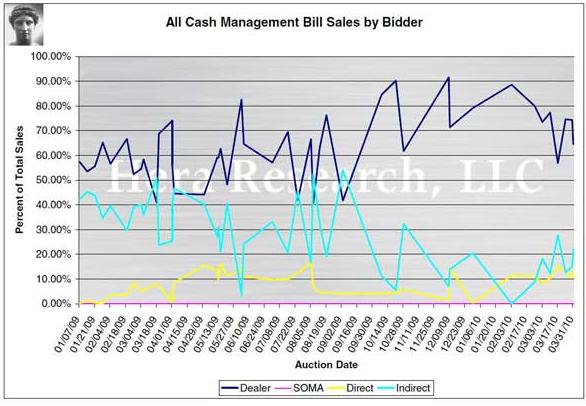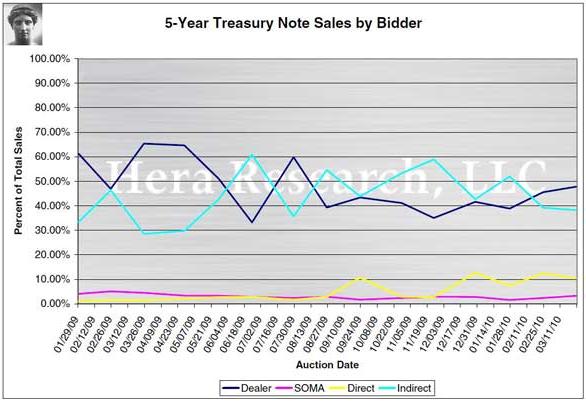不成功的(公債)拍賣
彰顯美國即將面臨債務危機
n 美國發行國債數量激增,但買氣同時下降
標題這句話應該要改成:
各國開始不「買」美國的「債」了
美國經濟得以持續維持不贅,
是因為美國藉著賣美國公債,
向全球國家與民眾「借錢」來花。
(就像一個人一直在寫「借據」,
然後別的人拿走借據之後拿真的錢給他)

Flimsy Auctions Signal
The US Is Heading For A Debt Crisis
一旦公債銷售不佳,
美國就會週轉不靈,
週轉不靈就會破產,
造成全球一片哀嚎。
什麼?為什麼美國跌了全球會哀嚎?
假設如果有一個人跟台灣全體國民
(注意,是全體國民,包括你在內
而且不是假設,美國就是這個人)
借了$46萬元新台幣
(外匯存底$3300億美元,除以2300萬人口)
然後宣布破產不還錢,
請問你會不會哀嚎?
這還只是用台灣外匯存底一項的試算而已,
還不包括民間與公司的美元現鈔,
以及用美元計價的海外基金投資、
存款與保單、進出口貿易結匯等。
開始瞭解Fred為什麼這麼關心這件事情了嗎?
金融海嘯並非只是歐美國家,
或國與國之間的問題,
它跟所有在使用鈔票的人有切身關係。
你會讓欠你$46萬台幣的人落跑嗎?
難道你不會想要保護自己,
把這些你花費青春
辛苦工作的錢賺回來嗎?
如果答案是的,
那麼敬請持續鎖定
「財富自由之聲」
為民喉舌的MTS_Fred的部落格!
xRon Hera | Apr. 8, 2010, 4:40 PM
(This guest post comes from Hera Research)
Investors often seek safety from financial market turbulence in US government bonds since they offer virtually no risk of default and, unlike cash or gold, provide a yield.
At the same time, sovereign debt default concerns outside the US, e.g., Iceland, Dubai, and Greece, have been linked to short-term rallies in the US dollar and have diverted attention from the fiscal challenges facing the US.
However, since seven US states are in worse financial condition than Greece, Ireland, Portugal or Spain, shelter may prove hard to find.
With a $3.83 trillion budget, a $12.3 trillion federal government debt, a $1.35 trillion 2010 budget deficit and $63 trillion in unfunded liabilities, the fiscal condition of the US has come into question and foreign interest in US Treasuries has declined. In late March, it was reported that the 10-year US Treasury Note yield had risen 30 basis points and that foreign holders of 10-year Notes were selling in record numbers.

Reports of US Treasury auction distress first appeared in December of 2009 when an article by Eric Sprott and David Franklin entitled “Is it All Just a Ponzi Scheme?” questioned the “Other Investors” reported by the US Federal Reserve. The unidentified investors held $359.1 billion worth of US Treasuries in the forth quarter of 2008 but $880.5 billion by the end of the third quarter 2009, an increase of $521.4 billion. Based on the Federal Reserve Flow of Funds Report, Messrs. Sprott and Franklin found the increase attributable to the “Household Sector”, which is defined in the Federal Reserve’s Flow of Funds Guide as “…amounts held or owed by the other sectors … subtracted from known totals … [such that] the remainders are assumed to be the amounts held or owed by the household sector.” Thus, the “Household Sector” is strictly an artifact of accounting practices, and, as a result, there has been some speculation regarding the parties responsible for $521.4 billion in 2009 US Treasury purchases.
A recent analysis of 4-week Treasury auction results by OmniSans Investment Research suggested that US Treasury auctions are more distressed than has been generally recognized, and a similar analysis appeared on the popular Zero Hedge website.

The OmniSans and Zero Hedge articles focus on the percent of Treasury auction purchases made by the Federal Reserve’s own primary dealers, as compared with other bidders, and on the percentage of indirect (foreign) bids accepted. In particular, the acceptance of 100% of foreign bids suggests extremely weak foreign demand. While the evidence is accurate, the conclusion is less clear since the changing pattern of US Treasury auction results is more complex.
Federal Reserve measures designed to increase financial market liquidity and to recapitalize the banking system, such as the Term Asset-Backed Securities Loan Facility (TALF), represent monetary inflation (or re-inflation), and some of this currency has certainly found its way into the coffers of the US Treasury, i.e., a rise in primary dealer purchases. A rise in primary dealer purchases could also be a result of the low cost of borrowing from the Federal Reserve. In theory, primary dealers can generate profits simply by borrowing from the Federal Reserve at near zero percent interest rates and buying Treasuries with higher yields. Of course, primary dealer purchases funded by borrowing from the Federal Reserve would be tantamount to debt monetization.
An increase in primary dealer purchases, or in purchases by direct bidders, could compensate for a decline in foreign purchases of US Treasuries but would not explain it. To be significant, a decline in foreign purchases would have to be evident in more than one type of Treasury, i.e., outside of the reported 1.0 bid to cover ratio for indirect bidders in recent 4-week Treasury Bill auctions.
What may be an emerging pattern of falling foreign demand and rising primary dealer purchases, both of which have been moderated by an increase in purchases made by direct bidders (financial institutions that place bids directly with the US Treasury, such as domestic depository institutions and mutual funds) is evident in 4-week Treasury Bill auction results.

Direct Federal Reserve purchases of US Treasuries (monetization) have been distributed over Treasuries of different types and maturities and have been generally implemented as a consistent, low-level of buying for particular Bills, Notes or Bonds. Overall, the Federal Reserve increased its holdings of US Treasuries by $286 billion in 2009, an increase of more than 60% as of September 2009 compared to 2008, and, as of March 2010, the Federal Reserve’s holdings of US Treasuries had increased another $14 billion to roughly $777 billion.
What is important is that monetization has been most significant in 4-week Treasury Bills, reaching 38.59% of total 4-week Treasury Bill sales on January 26, 2010, but similar spikes in Federal Reserve purchases do not appear in auction results for other types of Treasuries. Thus, it should come as no surprise that 4-week Treasury Bills have fallen out of favor with foreign investors.
Of course, the amount of currency created by monetization in a particular auction, regardless of the percent of Treasuries purchased by the Federal Reserve, represents only a small fraction of the monetary base. Nonetheless, there is not only a psychological dimension but also aggregate effects on the balance sheet of the Federal Reserve, on the US dollar and, ultimately, on the viability of US Treasury auctions.
A general pattern of decreased indirect bidder participation offset by rising direct bidder participation, setting aside any increase in primary dealer purchases, is evident outside of 4-week Treasury Bill auctions.

Foreign demand for 30-year Treasury Bonds has fallen over the past year, suggesting that foreign purchases may have shifted towards the short end of the maturity continuum. The more significant fact, however, is the marked increase in direct bidder purchasing, which has more than compensated for slack foreign demand at the extreme long end of the spectrum leaving primary dealer purchases flat.
Given the increase in direct bidder purchases, and reflecting on the questions raised by Messrs. Sprott and Franklin, it seems likely that the $521.4 billion worth of US Treasuries in 2009 reflects otherwise unclassified direct bidders, i.e., direct bidders other than recognized domestic investment funds and depository institutions. Unfortunately, the identities of the bidders remain unknown in any case.
The most dramatic example of primary dealer purchases replacing indirect (foreign) bidders is in Cash Management Bills, but these represent a rolling debt of perhaps $100 billion analogous to the corporate bond market and are not representative of other types of Treasuries.

While there are apparent signs of Treasury auction distress, based on a survey of Treasury auction data from January 2009 to March 2010, there is no indication of an immanent auction failure so long as the primary dealers and direct bidders continue to step into the breach. Further, the same patterns either do not appear or are much less pronounced in longer-term Treasury Note sales.

It seems unlikely that direct bidders within the US can compensate indefinitely, or to an unlimited extent, for falling foreign demand. Commenting on the ambitious spending plans of the US federal government, Zhu Min, Deputy Governor of the People's Bank of China said in December 2009 that "the world does not have so much money to buy more US Treasuries."
It would certainly be unreasonable for the US federal government and Federal Reserve to assume that ambitious deficit spending and ongoing quantitative easing (QE) would have no cumulative impact on US Treasury auctions. If there is a limit to foreign appetite for US debt, to foreign capacity to lend to the US, or to international tolerance for US dollar devaluation, the US government and Federal Reserve seem determined to find it.
China's foreign exchange reserves, valued at $2,399.2 billion at the end of December 2009 (not including gold), include only $894.8 billion in US Treasury bonds. In contrast, the US must issue or roll over $702 billion in debt in 2010 and a total of $2.55 trillion in Treasuries to be issued this year, while $3.7 trillion in US Treasuries are held abroad.
While US GDP was at $14.46 trillion in 2009 (with debt levels set to rise to 90% of GDP by 2020), China’s GDP is currently estimated as $8.791 trillion. Although there are signs of recovery in Chinese exports, the entire value of China's reserves, assuming that its current Treasury holdings could be liquidated, is insufficient to finance US federal government debt in 2010.
Since China recently liquidated $34 billion in US Treasuries, the statement of China’s Director of the State Administration of Foreign Exchange, Yi Gang, “[China is] a responsible investor and in the process of these investments we can definitely achieve a mutually beneficial result" seems obligatory. In reality, the US is currently the largest debtor nation in the history of the world, while China is the US’ largest creditor, and neither China nor any other country is in a position to bail out the US should US Treasury auctions run aground. Nonetheless, an overt Treasury auction failure seems impossible with the Federal Reserve as the lender of last resort to domestic depository institutions and to its own primary dealers. Unfortunately, direct monetary inflation is not without consequences. Specifically, increased debt monetization would impact the value of the US dollar and could spark high inflation, i.e., rising US dollar prices for imported goods and energy, or an eventual hyperinflationary collapse of the US dollar.
Without a robust economic recovery in the US, it seems unlikely that the apparent distress of US Treasury auctions will abate. Among other things, the gap between increasing US federal government spending and falling federal tax receipts is currently growing. A continuation of current US federal government and Federal Reserve policies under deteriorating economic conditions suggests levels of debt that could not be absorbed by US creditors, and a so-called double-dip recession would put extreme pressure on the US dollar. Indicators of Treasury auction distress include:
- Rising Treasury yields, regardless of interest rates, signaling inadequate demand.
- A continued decline in foreign bids, thus a higher percentage of accepted bids, particularly in additional types of Treasuries, outside of 4-week Treasury Bills.
- Direct bids failing to rise at a rate sufficient to offset falling indirect bidder demand, thus causing either primary dealer purchases or monetization to rise.
- A marked and sustained increase in primary dealer purchases versus direct or indirect bidders.
- Additional spikes in Federal Reserve purchases (monetization) in any type of Treasury, or a sustained increase in Federal Reserve Treasury purchases generally.
- An expansion of the incipient shift away from the long end of the maturity continuum towards shorter-term Treasuries.
原文(全)連結:
http://www.businessinsider.com/us-treasury-crisis-2010-4


 留言列表
留言列表